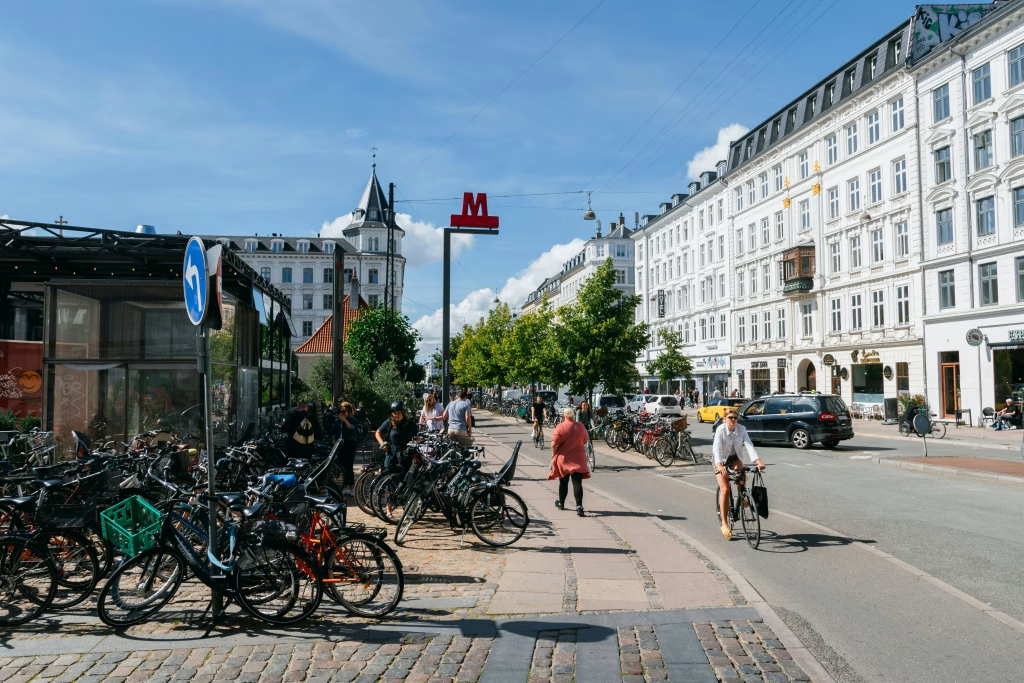If you’re planning a trip to Europe and looking to step off the typical tourist trail, Aarhus, Denmark’s second-largest city, deserves a place on your itinerary. Often overshadowed by Copenhagen, Aarhus is a thriving cultural hub that seamlessly blends Viking history with cutting-edge design, lush green spaces, and a youthful, creative energy. Whether you’re an art lover, foodie, nature enthusiast, or simply looking to experience a different side of Scandinavia, Aarhus offers a rich and rewarding experience—without the crowds.
Exploring Aarhus’ City Center and Architecture
A walk through the city feels like stepping through layers of history and innovation. In the charming Latin Quarter, you’ll find cobbled streets and centuries-old buildings housing independent boutiques, record stores, and cafés—perfect for grabbing a Danish pastry and people-watching. It’s one of the best areas in Aarhus to wander without an agenda.
Just a short stroll away, the sleek glass curves of Dokk1—the largest public library in the Nordics—and the contemporary ARoS Art Museum showcase Aarhus’ modern side. Don’t miss the iconic Your Rainbow Panorama, a 360-degree rooftop installation by Olafur Eliasson. It offers a colorful, panoramic view of the city and is both an artistic highlight and a great spot for photos.
Travel Tip: Many museums offer free entry for under-18s and other discounts. For deals and updated info, visit VisitAarhus. If you’re using public transport, consider a multi-day pass from DSB.
Art and Culture: Things to Do in Aarhus
Art and culture are central to life in Aarhus, earning it a reputation as Denmark’s cultural capital. The city boasts some of Northern Europe’s most innovative museums, including the avant-garde ARoS and the fascinating Den Gamle By—an open-air museum where historic Danish buildings are brought to life with costumed actors and period furnishings. It’s not just a museum; it’s an immersive time machine.
If you’re visiting in late summer, you’ll want to time your trip around the Aarhus Festival, a massive celebration of music, theater, food, and design that transforms the city into a creative playground. Streets fill with pop-up events, live performances, and art installations.
Local Tip: For a unique experience, check out Godsbanen, a former freight station turned creative hub with artist studios, street food stalls, and cultural events. It’s less polished than the museums but offers an authentic glimpse into the local art scene.
Where to Eat in Aarhus: Danish Cuisine and Street Food
No visit to Aarhus is complete without diving into its growing culinary scene. From Michelin-starred restaurants like Frederikshøj and Domestic to laid-back food halls like Aarhus Street Food, there’s something for every budget and craving.
Must-Try Dishes in Aarhus:
- Smørrebrød – Traditional open-faced sandwiches with toppings like pickled herring, roast beef, or egg and shrimp.
- Frikadeller – Danish meatballs, often served with potatoes and gravy.
- Danish pastries – Try one from La Cabra Coffee in the Latin Quarter.
Travel Tip: Many high-end restaurants offer excellent lunch menus at a fraction of the dinner price. Book ahead, especially on weekends. For casual dining, visit Kødbyens Food & Market (weekends only), where you can sample everything from Korean BBQ to vegan Danish comfort food.

Nature and Outdoor Activities in Aarhus
One of Aarhus’ most appealing features is how seamlessly it blends urban life with nature. You’re never more than a short walk or bike ride from greenery or the sea. Locals often head to Marselisborg Forests for hiking, biking, or simply relaxing among the tall pines.
If you’re visiting in warmer months, spend an afternoon at Den Permanente, a city beach with clean swimming water, sunbathing decks, and nearby cafés. Even in cooler months, a brisk walk along the Kattegat coast offers fresh air and scenic views.
More Outdoor Highlights:
- Botanical Gardens – Free entry, beautiful glasshouses, and peaceful walking trails.
- Deer Park (Dyrehaven) – Located within the forest, this fenced park lets you get up close to deer and wild boars—great for kids and nature lovers.
Weather Tip: Danish weather is famously unpredictable. Pack layers, a lightweight raincoat, and waterproof shoes—especially if you’re planning to explore on foot or by bike.
Design, Innovation, and Modern Attractions
Aarhus isn’t just steeped in history—it’s looking to the future. The city is a hub of Scandinavian design and sustainable living. One of the best examples is the Iceberg (Isbjerget), a futuristic residential development in the revitalized harbor district. Its sharp, jagged architecture mimics floating icebergs and is a favorite spot for architecture buffs and photographers.
Nearby, Aarhus Ø (the docklands) is one of the city’s fastest-evolving neighborhoods. Trendy cafés, rooftop bars, and floating saunas are popping up, creating a youthful, experimental vibe.
Design Tip: Visit the Aarhus School of Architecture or take a local design tour to learn more about Denmark’s influence on global architecture and city planning.
Local Vibes and Best Time to Visit Aarhus
What truly makes Aarhus shine is its atmosphere. Thanks to a large student population and a laid-back vibe, the city feels lively but never overwhelming. Locals are friendly and fluent in English, and the slower pace compared to bigger capitals like Copenhagen adds to its charm.
Best Time to Visit Denmark & Aarhus:
- Summer (June–August): Best weather, long daylight hours, and festivals. Book accommodations early.
- Fall (September–October): Fewer tourists, changing leaves, and cultural events.
- Winter (November–February): Cozy cafés, Christmas markets, and indoor museums—ideal if you enjoy a Nordic winter atmosphere.
Cultural Tip: Denmark has a strong “hygge” culture—cozy, candle-lit moments shared with friends over coffee or wine. Embrace it by visiting small cafés or wine bars around the Latin Quarter or Jægergårdsgade. Check out our article on experiencing hygge in Denmark.
How to Get to Aarhus and Getting Around
Getting to Aarhus is easier than you might think. It’s about a three-hour train ride from Copenhagen, with scenic views along the way. You can also fly into Aarhus Airport (AAR), which has limited but growing European connections, or Billund Airport (BLL), which is around 90 minutes away by bus.
Transportation Tips:
- Trains: Clean, efficient, and comfortable. Book tickets in advance via DSB.dk for discounts.
- Bikes: Aarhus is very bike-friendly. Rent one from Donkey Republic through their easy to use mobile app or at the train station.
- Walking: The city center is compact—perfect for exploring on foot.

Final Thoughts: Is Aarhus Worth Visiting?
Absolutely. Aarhus is one of the best hidden gems in Europe—ideal for travelers looking for authentic cultural experiences, great food, access to nature, and a more relaxed pace than major European capitals. Whether you’re exploring street art in the Latin Quarter, sipping coffee by the harbor, or hiking through ancient forests, Aarhus delivers a thoughtful blend of tradition and innovation that’s hard not to fall in love with.
So if you’re planning your next trip to Denmark, don’t just stop in Copenhagen—give Aarhus a few days, and you might find it’s your favorite part of the journey.
